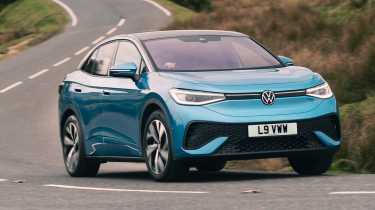Volkswagen ID.5 review - Electric motor, drive & performance
"The Volkswagen ID.5 is no sports car but it does well as a comfortable cruiser"
It may have a sporty silhouette, but the Volkswagen ID.5 is still a family-focused SUV that favours getting from A to B comfortably rather than impressing driving enthusiasts. Given the similarity between the ID.5 and the Volkswagen ID.4 it’s based on, the driving experience of the two cars is unsurprisingly familiar.
Comfort and refinement are good; even on our test car’s large 20-inch wheels, we didn’t feel too many of the lumps and bumps in the road, although it must be said that the suspension was noisier than that of rivals such as the Genesis GV60 and Nissan Ariya.
On the motorway, the ID.5 was composed and felt relaxing on a cruise. Thanks to its coupe-like shape, wind noise was kept to a minimum, so it felt like a nice place to be even at speed. Although it’s quite big, the ID.5’s tight turning circle and featherweight steering meant it felt very easy to manoeuvre around town.
However, a lack of steering feel and responsiveness in other scenarios means it feels a little uninspiring to drive generally. The steering also feels rather slow at moderate speeds, meaning you have to turn the wheel more than you might expect when leaving roundabouts, which can be a little disconcerting at times. We think the Nissan Ariya strikes a better balance between driving feel and comfort, while a Ford Mustang Mach-E or Kia EV6 offers more driving fun.
The semi-autonomous driving tech in the ID.5 works well. On the motorway, we set the adaptive cruise control and lane-keep assist, and the car did a good job of taking the stress out of the long cruise. The ID.5’s system can detect when you’re in the left lane and about to undertake a car in the lane to the right, and slows down accordingly – some other semi-autonomous driving systems we’ve tried will carry on even if there is a car in the lane to the right, which can be dangerous.
Volkswagen ID.5 electric motor
The Volkswagen ID.5 power options have changed a handful of times since launch. As of late 2024, there are just three options which go hand-in-hand with the various battery sizes. Entry-level cars are called ‘Pure’ and these get the 52kWh and a 168bhp electric motor. This model covers off the 0-62mph sprint in 8.9 seconds, which isn’t particularly quick but should be plenty if you’re coming from a traditional mainstream family car. The top speed for this model is slightly lower than that of the higher-spec models at 99mph.
The Pro model gets the 77kWh battery and is much punchier with 282bhp propelling it from 0-62mph in 6.7 seconds onto a top speed of 112mph. That’s much brisker than earlier ‘Pro Performance’ models which had just 201bhp, and is in fact almost as powerful as the older hot GTX model.
Speaking of the GTX, that model now gets 335bhp which is a power level similar to that of the petrol Volkswagen Golf R. We’re glad Volkswagen upped the power on this one compared to the 295bhp it had before, because when we first tested it it didn’t feel very sporty or special, so the extra 40bhp could go some way to alleviating that.
The ID.5 GTX goes from 0-62mph in 5.4 seconds and onto a limited top speed of 112mph. We’re glad Volkswagen didn’t use the GTI badge here, though. The ID.5 GTX may offer better straight-line performance than a Golf GTI, but despite this, it doesn’t feel particularly quick. Acceleration is a little quicker in Sport mode, but then the steering is a little lazy. It handles lower-speed corners well, but comes unstuck in faster bends because it’s keen to push wide. Ultimately, it’s best driven at a cruise rather than as a B-road blitzer, which limits its appeal as a performance model. We’d avoid the GTX for these reasons, and think the standard version represents better value for money.










